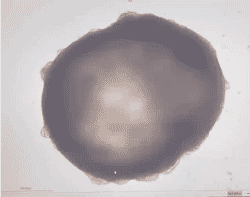Organoide - Info

Überblick
- What are organoids?
- How do you grow organoids?
- Possible applications of organoids
- Models for genetic diseases
- Research into infectious diseases
- Models for metabolic diseases
- Investigation of cancer diseases
- Drug discovery and development
- Personalised medicine
- Organoids - a replacement for animal testing?
- Products
What are organoids?
 Organoids are 3D tissue models derived from stem cells that are structurally and physiologically similar to real organs. They consist of different cell types and are usually cultivated in a gel-like matrix that contains proteins and polyvalent sugar compounds important for cell growth in order to replicate the natural extracellular matrix (ECM). By adding various growth factors, the stem cells can differentiate into different cell types and form a network of vessels, muscle cells and connective tissue. This overcomes the limitations of a classic 2D cell culture, which consists of only one cell type and is only arranged in two dimensions.
Organoids are 3D tissue models derived from stem cells that are structurally and physiologically similar to real organs. They consist of different cell types and are usually cultivated in a gel-like matrix that contains proteins and polyvalent sugar compounds important for cell growth in order to replicate the natural extracellular matrix (ECM). By adding various growth factors, the stem cells can differentiate into different cell types and form a network of vessels, muscle cells and connective tissue. This overcomes the limitations of a classic 2D cell culture, which consists of only one cell type and is only arranged in two dimensions.
How do you grow organoids?
Organoids are cultivated from adult (ASCs), embryonic (ESCs) or induced pluripotent stem cells (iPSCs). Organoids can also be cultivated from tumour cells.
Alternatively, organoids can also be cultivated outside a gel matrix, e.g. using the hanging drop method in which the organoids are suspended in a medium drop on the underside of a cell culture plate. Due to the surface tension of the droplet, the organoids remain inside the droplet and can thus be separated more easily from their growth medium.
Another method is organoid chips, in which the organoids are cultivated in a controlled and continuous flow of liquid.
Possible applications of organoids
Models for genetic diseases
Organoids can replicate organs in vitro and model genetic diseases. The combination with gene editing technologies such as CRISPR-Cas9 enables deeper insights into the causes and treatment options of genetic diseases.
Research into infectious diseases
Organoids provide human models for research into infectious diseases. They enable the study of viruses such as Zika, norovirus, hepatitis viruses and SARS-CoV-2 as well as bacteria and parasites. Organoids make it possible to investigate the interactions between different cell types and tissues as well as the reactions to infections and immune responses in a complex environment, whereas only one cell type can be studied in a 2D cell culture. These 3D models support research into disease mechanisms, the development of new therapies and the understanding of tumour development through infections.
Models for metabolic diseases
Adipose organoids enable the study of fat metabolism and obesity. Liver organoids can be used to study the mechanisms of fat deposition in the liver and the development of fatty liver disease, including the effects of diet and drugs. This allows deeper insights into the disease to be gained in order to develop new therapeutic options.
Investigation of cancer diseases
Tumour models such as cell lines and patient-derived xenograft (PDX) have limitations as they do not fully reflect tumour heterogeneity and genetic diversity. Organoids, on the other hand, better preserve the 3D structure and genetic characteristics of tumours. They enable the study of tumour development, metastases and immunotherapies, provide more realistic models for research and enable more accurate predictions of treatment efficacy.
Drug discovery and development
Organoids offer unique advantages in drug discovery as they can mimic the physiological functions of organs. They enable the discovery of new drugs and, above all, the assessment of drug toxicity. This leads to more realistic results than with 2D cell cultures. In addition, drugs can be tested in a high-throughput process, which saves a considerable amount of time and increases efficiency.
Personalised medicine
Organoids can be produced from patient samples, allowing researchers to study specific diseases on an individualised basis. This promotes personalised medicine and enables the development of tailored treatment strategies.
Organoids - a replacement for animal testing?
The classic way of researching diseases is via suitable animal models, but animal experiments are associated with a great deal of bureaucracy. This is primarily to protect the animals. Since the introduction of the 3Rs principle (Reduce, Refine, Replace), animal experiments have been more strictly regulated and require more intensive testing by the relevant authorities in order to protect animals from unnecessary experiments.
As a result, organoids are a good way of testing drugs for efficacy and toxicity in the preclinical phase. They provide more information about the effect of the drug than conventional 2D cell cultures, as they are physiologically very similar to human organs and could also be used to test toxicity and pharmacokinetics. However, organoids are currently only approved as an addition to animal experiments, as no standardisation and validation of organoids has yet taken place that would guarantee the reproducibility of results.
Products for research with organoids:
| Products | Manufactuer | Art. Nr. | Amount | |
|---|---|---|---|---|
| Basement Membrane Matrix for Organoid Culture | MedChem Express | HY-K6007-5mL HY-K6007-10mL |
5 mL 10 mL |
|
| Mogengel Matrix Organoid Culture | ACRO Biosystems | AC-M082755-5ml AC-M082755-10ml |
5 mL 10 mL |
|
| human iPSCs | Angio Proteomie | ANG-cAP-0500 | 1 Frozen Vial | |
| HighQC™Reprogrammed Human IPS Cell | AcceGen | ACG-ABC-SC2120 | 1 vial | |
| iPSC Culture Medium (Xeno-free; Serum-free) | Angio Proteomie | ANG-cAP-49-500ml | 500 ml | |
| Human iPSC-Derived Cardiac Organoid Maintenance Kit | ACRO Biosystems | RIPO-HWM004-1kit | 1 kit | |
| HANABI Avatar™ Colon Organoid Growth Media – Human | ADS Biotec | ADSB-709038-1 ADSB-709038-10 ADSB-709038-100 |
1 ea 10 ea 100 ea |
|
| Human Breast Cancer Organoid Kit | MedChem Express | HY-K6101-100mL HY-K6101-500mL |
100 mL 500 mL |
|
| human iPSC Enhancer Kit | Sellekchem | K2010 | 500 ul | |
| FBS Standard, South America origin, fetal bovine serum, 0.2 µm sterile filtered | PAN Biotech | P30-3306 | 500 ml | |
| human R-Spondin 1 protein, active | Cloud Clone | APM171Hu61-10ug APM171Hu61-50ug APM171Hu61-100ug APM171Hu61-200ug |
10 ug 50 ug 100 ug 200 ug |
|
| human Noggin (NOG) protein, active | Cloud Clone | APC130Hu01-50ug APC130Hu01-100ug APC130Hu01-200ug |
50 ug 100 ug 200 ug |
|
| human Laminin 521 protein (research grade) | KactusBio | LMN-HM522-100UG LMN-HM522-100UGX5 |
100 ug 100 ug x 5 |
|
| Ready-to-use human iPSC-derived cardiac organoid | ACRO Biosystems | CIPO-HWL002K-1organoid CIPO-HWL002K-100organoids |
1 organoid 100 organoids |
|
| Ready-to-use human iPSC-derived cerebral organoid | ACRO Biosystems | CIPO-BWL001K-1organoid CIPO-BWL001K-100organoids |
1 organoid 100 organoids |
|
| Anti-Human CD166 (ALCAM) (Clone 3A6) – Purified in vivo PLATINUM™ Functional Grade | Leinco Technologies | LEIN-C712-1.0mg LEIN-C712-5.0mg LEIN-C712-25mg LEIN-C712-50mg LEIN-C712-100mg |
1 mg 5 mg 25 mg 50 mg 100 mg |
|
| Anti-Human CD40 (Clone G28.5) – Purified in vivo GOLD™ Functional Grade | Leinco Technologies | LEIN-C2825-1mg LEIN-C2825-5.0mg LEIN-C2825-25mg LEIN-C2825-50mg LEIN-C2825-100mg |
1 mg 5 mg 25 mg 50 mg 100 mg |
|
| (1S,2S)-Bortezomib | Molnova | MOLN-M26020-1mg MOLN-M26020-2mg MOLN-M26020-5mg MOLN-M26020-10mg MOLN-M26020-25mg MOLN-M26020-50mg MOLN-M26020-100mg MOLN-M26020-200mg MOLN-M26020-500mg |
1 mg 2 mg 5 mg 10 mg 25 mg 50 mg 100 mg 200 mg 500 mg | |
| Obatoclax mesylate (GX15-070) | APExBIO Technology | APEX-A4194-S APEX-A4194-5 APEX-A4194-10 APEX-A4194-25 APEX-A4194-50 APEX-A4194-5.1 |
Evaluation Sample 5 mg 10 mg 25 mg 50 mg 10mM (in 1 ml DMSO) |
|
| RapiClear® 1.47 | SUNJin Lab | SUJI-RC147001 SUJI-RC147002 |
10 ml 100 ml |
|
| VitroGel Cell Recovery Solution 100mL | BioGems | V3D-CRS-100ml | 100 mL | |
| 3D Organoid Cell Viability Assay | Assay Genie | ASGE-AKES081-100Assays ASGE-AKES081-500Assays |
100 Assays 500 Assays |



